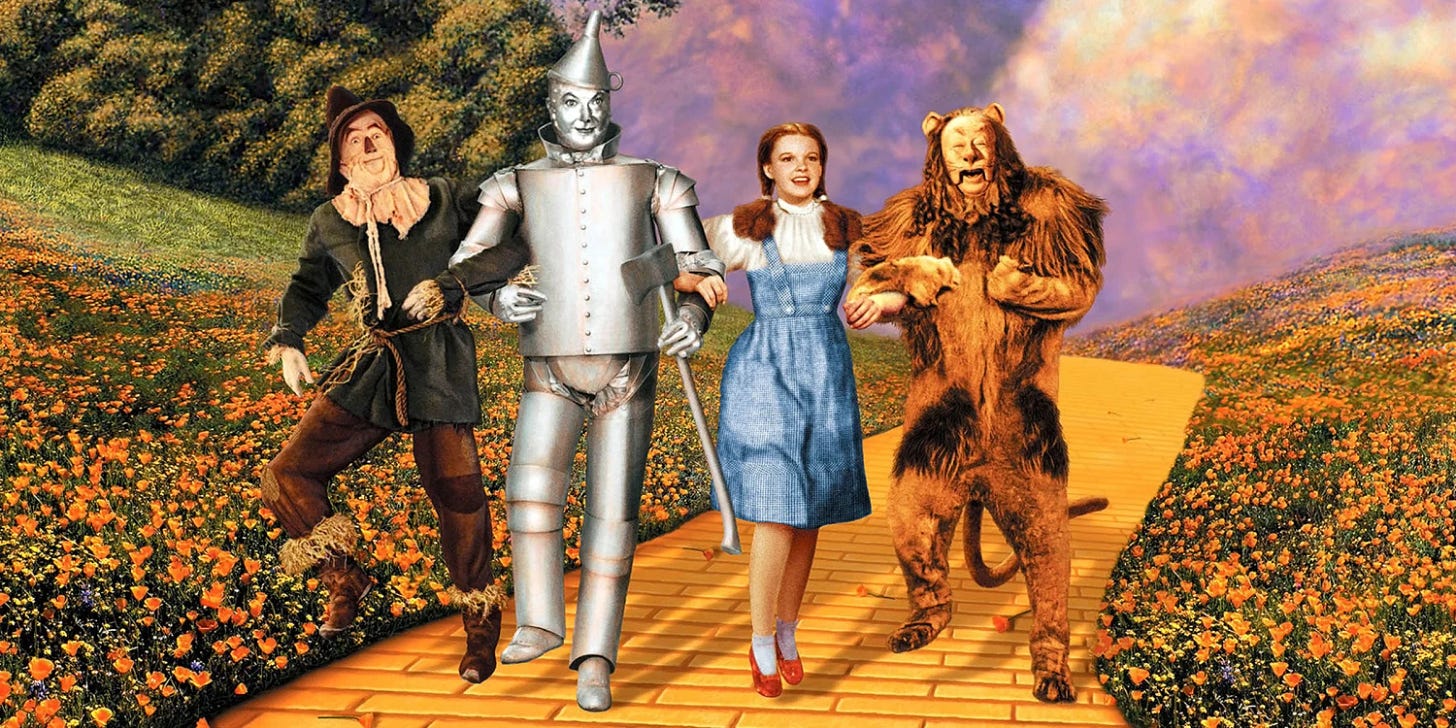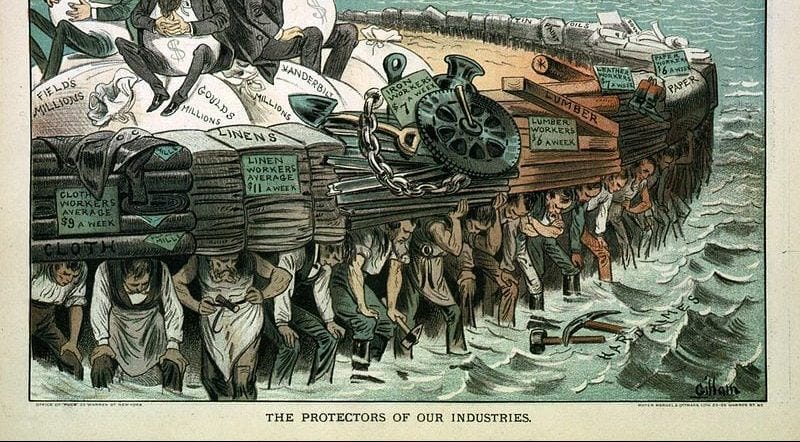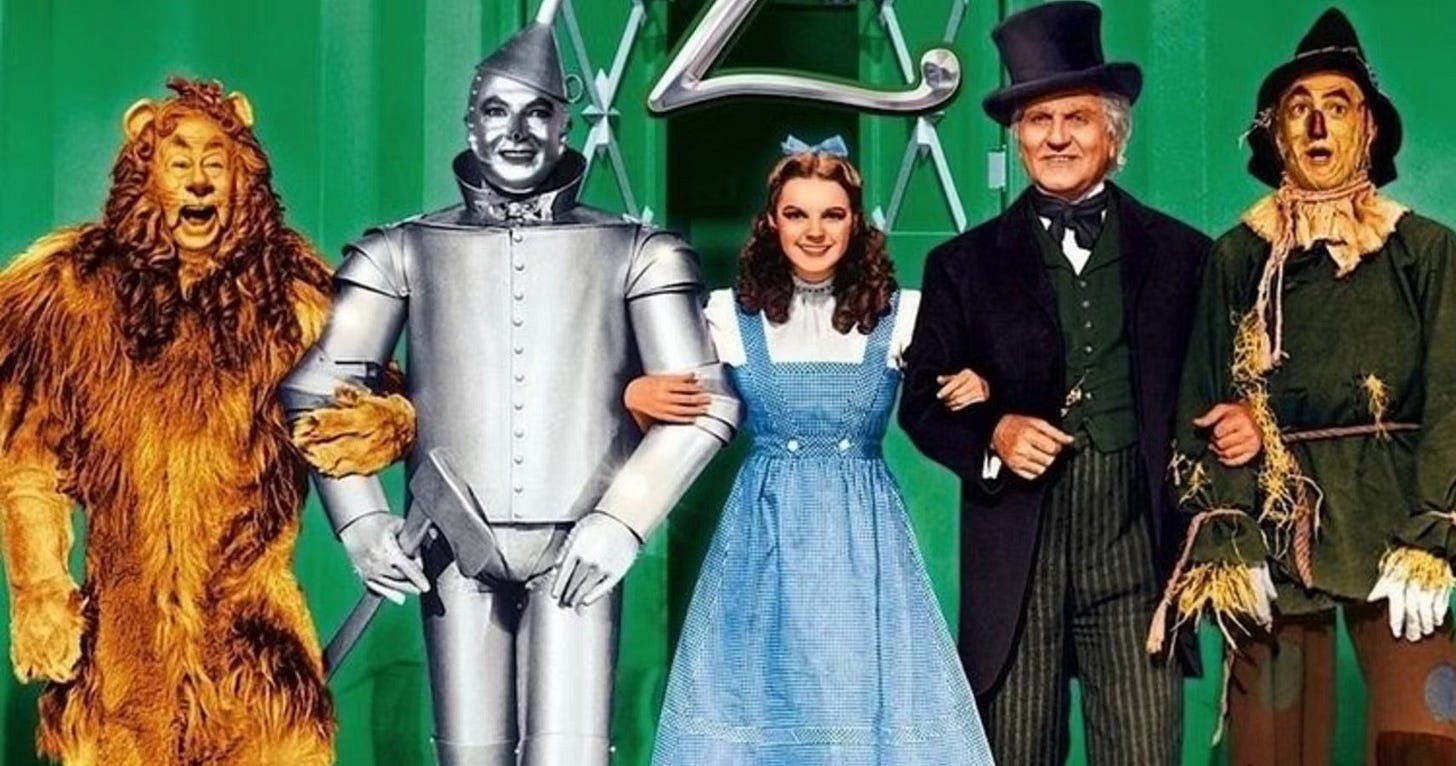The Hidden Heartland: “The Wizard of Oz,” A Parable On Early American Populism?
Exploring the Debate
In the heart of L. Frank Baum's cherished tale, "The Wizard of Oz," a young girl from Kansas, swept away by a mighty tornado, lands in the enigmatic world of Oz. There, she encounters the Scarecrow, who laments his lack of a brain, yet frequently displays profound insight and wisdom. This scene, emblematic of the story's enduring charm and apparent simplicity, invites readers into a world replete with symbolism and hidden depths. As Dorothy embarks on her journey along the Yellow Brick Road, ostensibly to seek help from the great and powerful Oz, readers of all ages are drawn into a narrative rich with allegorical potential.
This article delves into the vigorous academic debate surrounding "The Wizard of Oz": is this merely a delightful children's story, or is it a cleverly disguised commentary on the socio-political landscape of Baum's America? Since its publication in 1900, scholars and critics have mined the text for evidence of a deeper allegorical meaning, particularly one aligned with the populist sentiments of Baum’s contemporaries. This investigation explores the historical context of the late 19th and early 20th centuries, key populist themes, and the diverse interpretations that have positioned Baum's work as a potential vehicle for social and economic critique. Through this exploration, the article seeks not only to illuminate the various dimensions of Baum's narrative but also to understand how "The Wizard of Oz" reflects the complexities of American society during a pivotal era of change and reform.
Historical Context
Frank Baum, born in 1856 in New York, emerged as a notable figure in American literature with the publication of "The Wizard of Oz" at the turn of the century. A prolific writer and a man of complex personal beliefs, Baum's political views, and their potential influence on his most famous work have long intrigued scholars and readers alike. Before delving into the allegorical interpretations of his work, it is crucial to understand the political and social climate of Baum's America, particularly the emergence and influence of the Populist movement during the late nineteenth and early twentieth centuries.
The Populist movement, which arose in response to the economic distress affecting the nation's agrarian sectors, sought to challenge the dominance of the eastern financial and political elites. Central to their agenda was the demand for the free coinage of silver, a policy they believed would remedy the deflationary pressures that were crippling American farmers. Baum's exposure to these socio-political issues likely came during his time in South Dakota, where he owned a store and later edited a local newspaper in a small town deeply affected by these economic struggles.
During this period, the debate over monetary standards—symbolized through the gold standard versus silver coinage—reached its zenith with William Jennings Bryan's famous "Cross of Gold" speech at the 1896 Democratic National Convention. Bryan, representing the fusion of Populist and Democratic interests, argued passionately for bimetallism (the use of both gold and silver as currency), which he claimed would restore economic equilibrium and assist struggling farmers and workers. This contentious backdrop provides a fertile ground for interpreting "The Wizard of Oz" as an allegory, with the Yellow Brick Road potentially representing the gold standard and the silver shoes (ruby in the film adaptation) Baum's nod to the silver solution.
As the Populist movement waned at the end of the century, its ideas and the broader social reforms it advocated for left a lasting imprint on American social and political life, influencing subsequent reform movements and shaping public policy discussions. Baum's work, written during and perhaps influenced by this era of intense political reform and economic upheaval, captures the spirit of his times, embedding within a children's narrative deeper reflections on societal values and fears.
Through this historical lens, "The Wizard of Oz" can be seen not just as a product of Baum's imagination but as a reflection of the political and economic debates of his time. Whether Baum intended for his work to be read as a direct populist allegory remains subject to scholarly debate, but the historical context undoubtedly enriches the interpretations of his literary masterpiece.
Literary Analysis
In the examination of "The Wizard of Oz" as a potential allegory for the populist sentiment of the late 19th century, key elements of the narrative can be interpreted through the lens of political symbolism. As Dorothy travels the Yellow Brick Road—a path paved with gold, she wears silver shoes (translated to ruby slippers in the 1939 film adaptation), which some scholars suggest represent the economic debate between gold, the standard, and silver, the underrepresented challenger in the monetary system. This interpretation resonates with the populist advocacy for bimetallism, which aimed to incorporate silver in addition to gold as a standard to inflate the shrinking money supply that was crippling farmers and small businesses.
Additionally, the characters Dorothy meets along her journey—the Scarecrow, the Tin Woodman, and the Cowardly Lion—have been analyzed as representations of different segments of American society. The Scarecrow, with his desire for a brain, mirrors the common portrayal of farmers as lacking wisdom, yet he displays intelligence and resourcefulness, challenging the stereotype. Similarly, the Tin Woodman, rusted solid when Dorothy finds him, symbolizes the dehumanizing effects of industrialization on factory workers and laborers. He longs for a heart, suggesting a loss of human empathy in the face of industrial expansion.
The Cowardly Lion, often thought to represent William Jennings Bryan, who was a dominant figure in the populist movement, is criticized for his lack of courage. Bryan, known for his eloquent speeches and charismatic leadership, nonetheless was often depicted as lacking the fortitude necessary to bring about real change, especially following his compromises with the Democratic Party. This allegorical reading lends depth to Baum's characters, transforming them from mere companions on a fantastical journey to symbols of a socio-political critique.
Furthermore, the Wizard himself can be seen as a critique of the authoritative figures in American politics who manipulate public perception. The Wizard's façade of omnipotence and his use of elaborate tricks to maintain his authority echo the manipulative practices of political leaders of Baum’s time, who could dazzle the populace while lacking the actual power or intent to fulfill their promises.
Despite these interpretations, Baum's text offers a rich tapestry that allows for multiple readings, and the author himself never confirmed any intended allegory. This multiplicity of possible interpretations highlights the text's richness and the depth of its engagement with its historical and cultural context. As readers and scholars, the exploration of these allegorical elements provides not only a deeper understanding of the narrative itself but also of the American societal values during Baum’s era.
Impact on American Popular Culture
Whether interpreted through a populist lens or appreciated as a timeless narrative of adventure and self-discovery, the story has profoundly influenced American cultural identity and has been a touchstone for numerous social and political discussions. The allegorical reading of Baum's work as a commentary on populist themes has especially enriched its cultural significance, offering a layer of depth that resonates with audiences aware of its historical context.
The 1939 film adaptation, in particular, played a pivotal role in cementing "The Wizard of Oz" as a cultural icon. Its transition from silver shoes in the book to ruby slippers in the film highlighted the technological marvel of Technicolor but also shifted the potential allegorical interpretations associated with the silver standard. This adaptation, along with its memorable music and vivid imagery, has kept the story alive in the American consciousness, making it a perennial favorite and a critical tool for educators teaching about the power of allegories in literature.
Furthermore, the story's themes of resilience, the quest for identity, and the critique of authority have allowed it to be repurposed by various social movements over the years. For example, during the 1960s and 1970s, "The Wizard of Oz" was adopted by the civil rights and feminist movements as a metaphor for the journey toward equality and empowerment. The narrative's broad applicability and universal themes make it an enduring vessel for commentary and reflection on social issues.
Academic engagement with the text has also spurred continued interest and debate. Scholarly works, such as those by Littlefield and Rockoff, have not only supported deeper analyses of the text from an economic and political standpoint but have also encouraged a broader public discussion about the influences on Baum at the time of the writing. These discussions have fostered a more nuanced understanding of the book and its adaptations, highlighting the dynamic interplay between art and societal values.
In contemporary times, "The Wizard of Oz" remains relevant, as evidenced by its frequent references in political rhetoric, where politicians from various spectrums use it to address issues of deception, true leadership, and the virtues of heart, brain, and courage in governance. This enduring relevance underscores the tale's capacity to serve as a cultural mirror and a medium for societal critique.
Conclusion
In concluding this exploration of "The Wizard of Oz" as both a cherished children's narrative and a possible allegory for populist social commentary, we are reminded of the powerful role American literature plays in the ongoing dialogue about society and its values. Stories like Baum's, which are rich with layers of meaning—whether intended by the author or interpreted by the reader—serve as a mirror reflecting the complexities of the human condition and the societal currents of their times.
The question of whether the true meaning of a work lies in the author's original intent or in the interpretations of its audience is as old as literature itself. In the case of "The Wizard of Oz," L. Frank Baum never explicitly stated that his novel was intended as a political allegory, leaving room for decades of debate and discussion. This ambiguity highlights an essential aspect of literary works: they are not static artifacts but dynamic texts that interact with each cultural and historical context in which they are read. The richness of Baum's creation, therefore, is not solely in the text itself but also in the myriad ways it has been interpreted, reimagined, and repurposed over more than a century.
American literature, in this capacity, serves as a fertile ground for social commentary, offering insights not only into the mind of the author but also into the minds of its readers and the societal norms of the periods during which it is read. Each interpretation, whether aligning with the author’s original intent or diverging from it, contributes to the ongoing discourse about values, norms, and the very fabric of American life.
Therefore, whether Baum intended for his tale of a young girl's fantastical journey to be a reflection of the populist zeitgeist of the early 1900s or merely a whimsical story for children, "The Wizard of Oz" endures as a seminal piece of American literature capable of sparking debate and fostering reflection. In this light, the story serves as a testament to the enduring power of literature to transcend its original context and speak to universal themes of power, identity, and resilience. It invites us to continually reevaluate our interpretations and the impact of historical context on literary analysis, enriching both our understanding of the text and of ourselves.
As we reflect on "The Wizard of Oz" and its place in American literature, we are reminded that the true power of a literary work may indeed rest not in the specific intent of its creator, but in its capacity to be a canvas upon which each generation can project its concerns, hopes, and dreams. In this ongoing dialogue between text and reader, literature fulfills its most profound function: it challenges, comforts, and ultimately helps us to navigate the complex landscapes of our social and personal lives.
Bibliography for Further Reading
Bryan, William Jennings. "Cross of Gold Speech." Democratic National Convention, 1896.
Culver, Stuart. "What Manikins Want: The Wonderful Wizard of Oz and The Art of Decorating Dry Goods Windows and Interiors." Representations, no. 21, 1988, pp. 97-116.
Dighe, Ranjit S., ed. The Historian's Wizard of Oz: Reading L. Frank Baum's Classic as a Political and Monetary Allegory. Praeger, 2002.
Greene, David L., and Dick Martin. The Oz Scrapbook. Random House, 1977.
Harmetz, Aljean. The Making of The Wizard of Oz: Movie Magic and Studio Power in the Prime of MGM — and the Miracle of Production #1060. Hyperion, 1998.
Littlefield, Henry M. "The Wizard of Oz: Parable on Populism." American Quarterly, vol. 16, no. 1, 1964, pp. 47-58.
Parker, David B. "Ideas of the Gold Standard and Silver Coinage: Economic Discourses in the 19th Century America." Journal of American Economic History, vol. 24, no. 2, 2001, pp. 76-88.
Rockoff, Hugh. "The 'Wizard of Oz' as a Monetary Allegory." Journal of Political Economy, vol. 98, no. 4, 1990, pp. 739-760.
Rogers, Katherine M. L. Frank Baum, Creator of Oz: A Biography. St. Martin's Press, 2002.
Swartz, Omar. "The Political Legacy of American Populism." Valahian Journal of Historical Studies, no. 20, 2013, pp. 21-34.







